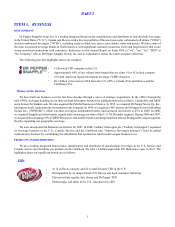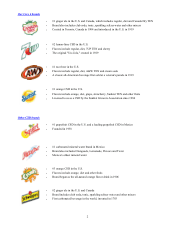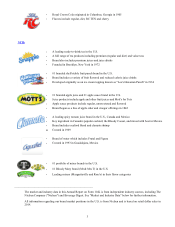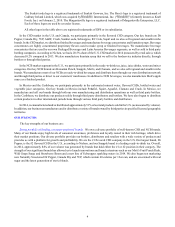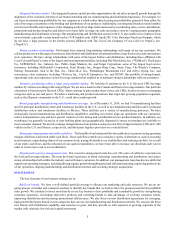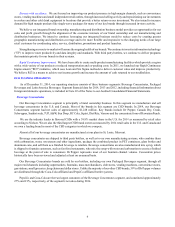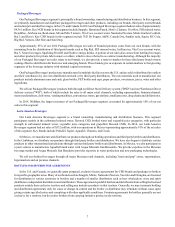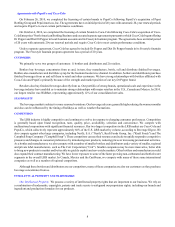Snapple 2014 Annual Report Download - page 14
Download and view the complete annual report
Please find page 14 of the 2014 Snapple annual report below. You can navigate through the pages in the report by either clicking on the pages listed below, or by using the keyword search tool below to find specific information within the annual report.
11
REGULATORY MATTERS
We are subject to a variety of federal, state and local laws and regulations in the countries in which we do business. Regulations
apply to many aspects of our business, including our products and their ingredients, manufacturing, safety, labeling, transportation,
recycling, advertising and sale. For example, our products and their manufacturing, labeling, marketing and sale in the U.S. are
subject to various aspects of the Federal Food, Drug, and Cosmetic Act, the Federal Trade Commission Act, the Lanham Act, state
consumer protection laws and state warning and labeling laws. In Canada and Mexico, the manufacture, distribution, marketing
and sale of our many products are also subject to similar statutes and regulations. Additionally, the government of Mexico enacted
broad based tax reform, including a one peso per liter tax on the manufacturing of certain sugar-sweetened beverages, which went
into effect January 1, 2014, as a result of concerns about the public health consequences and health care costs associated with
obesity.
We and our bottlers use various refillable and non-refillable, recyclable bottles and cans in the U.S. and other countries. Various
states and other authorities require deposits, eco-taxes or fees on certain containers. Similar legislation or regulations may be
proposed in the future at local, state and federal levels, both in the U.S. and elsewhere. In Mexico, the government has encouraged
the soft drink industry to comply voluntarily with collection and recycling programs of plastic material, and we are in compliance
with these programs.
ENVIRONMENTAL, HEALTH AND SAFETY MATTERS
In the normal course of our business, we are subject to a variety of federal, state and local environmental, health and safety
laws and regulations. We maintain environmental, health and safety policies and a quality, environmental, health and safety program
designed to ensure compliance with applicable laws and regulations. The cost of such compliance measures does not have a
material financial impact on our operations.
AVAILABLE INFORMATION
Our web site address is www.drpeppersnapplegroup.com. Information on our web site is not incorporated by reference in this
document. We make available, free of charge through this web site, our annual reports on Form 10-K, quarterly reports on Form
10-Q, current reports on Form 8-K and amendments to those reports filed or furnished pursuant to the Securities Exchange Act
of 1934, as amended, as soon as reasonably practicable after such material is electronically filed with, or furnished to, the Securities
and Exchange Commission.
MARKET AND INDUSTRY DATA
The market and industry data in this Annual Report on Form 10-K is from independent industry sources, including Nielsen
and Beverage Digest. Although we believe that these independent sources are reliable, we have not verified the accuracy or
completeness of this data or any assumptions underlying such data.
Nielsen is a marketing information provider, primarily serving consumer packaged goods manufacturers and retailers. We
use Nielsen data as our primary management tool to track market performance because it has broad and deep data coverage, is
based on consumer transactions at retailers, and is reported to us monthly. Nielsen data provides measurement and analysis of
marketplace trends such as market share, retail pricing, promotional activity and distribution across various channels, retailers and
geographies. Measured categories provided to us by Nielsen Scantrack include CSDs, energy drinks, single-serve bottled water,
non-alcoholic mixers and NCBs, including ready-to-drink teas, single-serve and multi-serve juice and juice drinks, and sports
drinks. Nielsen also provides data on other food items such as apple sauce. Nielsen data we present in this report is from Nielsen's
Scantrack service, which compiles data based on scanner transactions in key retail channels, including grocery stores, mass
merchandisers (including WalMart), drug chains, convenience stores and gas stations. However, this data does not include the
fountain or vending channels, or small independent retail outlets, which together represent a meaningful portion of the U.S. LRB
market and of our net sales and volume.
Beverage Digest is an independent beverage research company that publishes an annual Beverage Digest Fact Book. We use
Beverage Digest primarily to track market share information and broad beverage and channel trends. This annual publication
provides a compilation of data supplied by beverage companies. Beverage Digest covers the following categories: CSDs, energy
drinks, bottled water and NCBs (including ready-to-drink teas, juice and juice drinks and sports drinks). Beverage Digest data
does not include multi-serve juice products or bottled water in packages of 1.5 liters or more. Data is reported for certain sales
channels, including grocery stores, mass merchandisers, club stores, drug chains, convenience stores, gas stations, fountains,
vending machines and the "up-and-down-the-street" channel consisting of small independent retail outlets.


